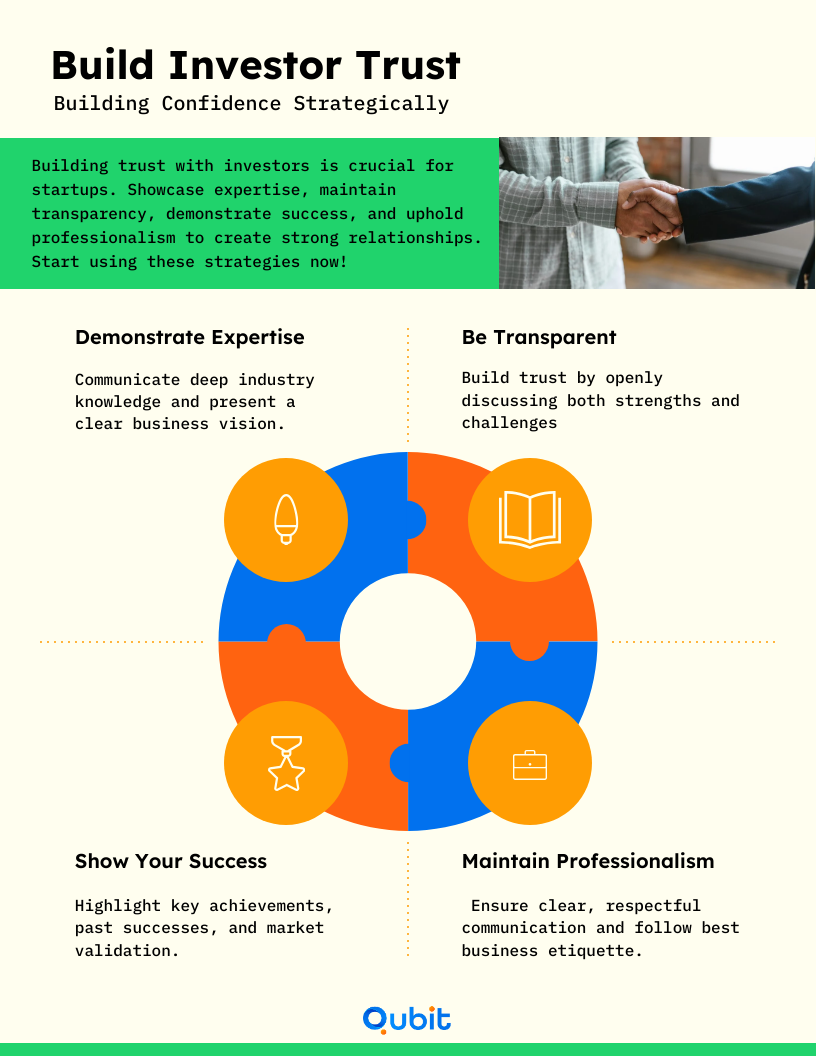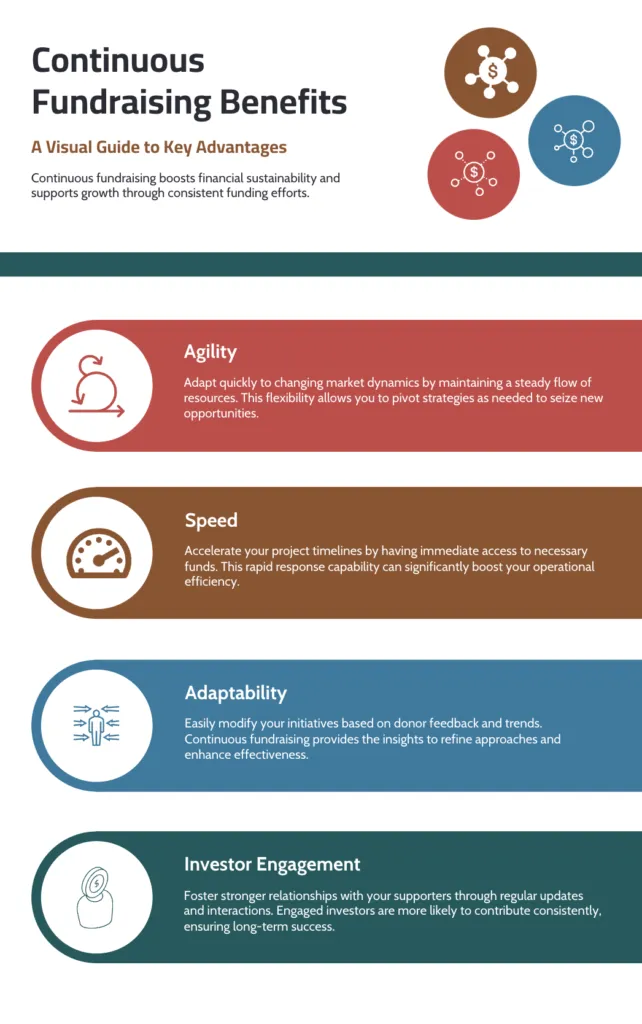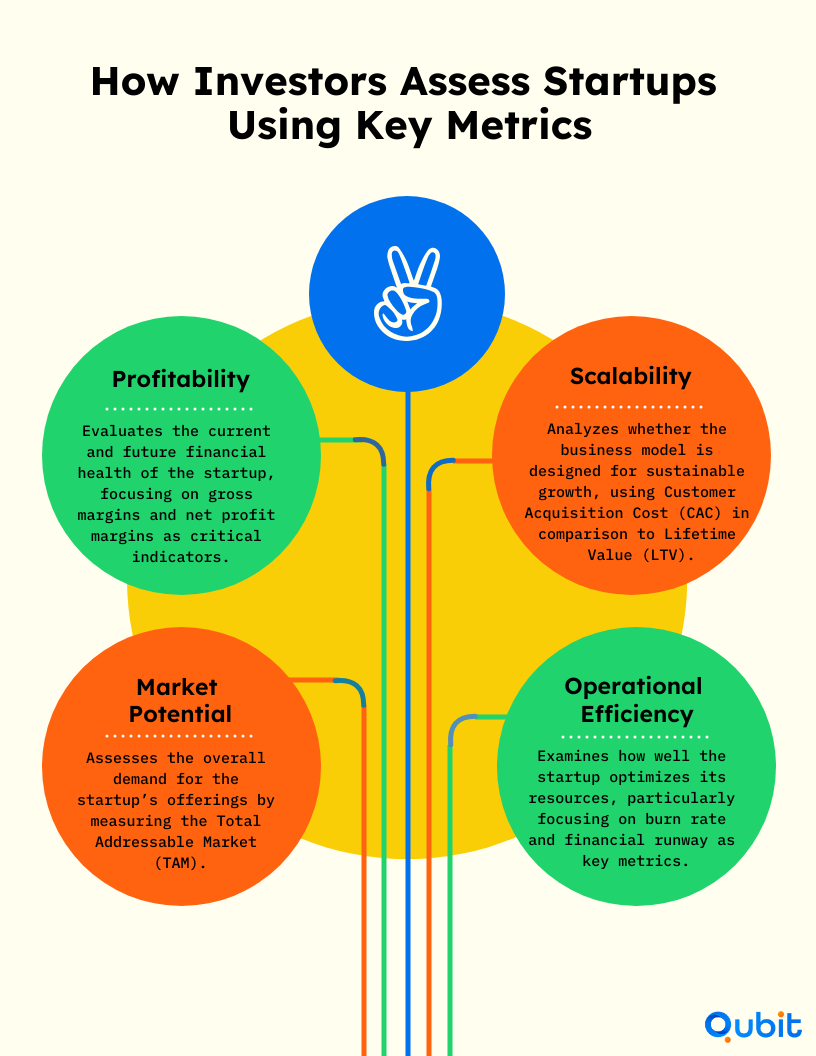Securing capital isn’t just about finding any investor; it’s about connecting with the right ones who align with your mission and values. This process can be overwhelming, but there’s a strategic approach that can simplify your fundraising efforts.
Investment mapping is a powerful technique that enables startups to systematically identify and engage with investors best suited to their ventures.
This comprehensive guide explores actionable strategies to master investment mapping. You’ll be equipped with practical tools to find your perfect investor match.
To see how investment mapping fits into your fundraising journey, explore our startup funding stages guide. Now let’s see how investment mapping can transform your fundraising process and accelerate your startup’s growth.
Understanding Investment Mapping
What Are Investment Mapping Techniques?
Investment mapping techniques involve a systematic approach to identifying and categorizing potential investors who share your startup’s mission, values, and funding requirements.
Think of it as creating a detailed map that guides you to investors most likely to support and invest in your venture. By leveraging these techniques, startups can focus on building meaningful relationships with the right investors rather than casting a wide net.
Importance: Time and resources are precious, so investment mapping simplifies the fundraising process by:
- Targeting Suitable Investors: Ensuring outreach efforts concentrate on investors with a high probability of interest.
- Personalizing Engagement: Tailoring communication to resonate with investors’ preferences and past investments.
- Building Stronger Relationships: Establishing connections based on shared values and goals.
According to a study by Harvard Business Review, startups that strategically target investors are more likely to secure funding than those that don’t employ targeted approaches.
Why Is Investment Mapping Important for Startups?
- Accelerates Fundraising: By focusing on investors who are a good fit, you reduce time spent on fruitless pitches, making your fundraising efforts more effective.
- Enhances Investor Relationships: Personalized communication fosters trust and rapport, laying the groundwork for long-term partnerships.
- Increases Success Rates: Targeted outreach improves the likelihood of securing investment, as you’re reaching out to those with a demonstrated interest in your sector.
A survey revealed that startups using investment mapping techniques raised 20% more capital on average compared to those that did not.
As Benjamin Franklin wisely said, “An investment in knowledge pays the best interest.” In this context, knowledge of your potential investors is invaluable.
Investment Mapping in the Startup Funding Journey
Investment mapping isn’t a one-size-fits-all strategy; it evolves as your startup progresses through different funding stages. Here’s how it integrates into each phase:
- Seed Stage: Focus on angel investors, seed funds, and early-stage venture capitalists willing to take risks on unproven concepts. Personal connections and belief in your vision are crucial here.
- Series A to C: Target venture capital firms with a track record of investing at your stage. Emphasize traction, market fit, and scalability.
- Growth Stage: Seek investors interested in scaling operations, such as late-stage VCs or private equity firms. Highlight your growth metrics and expansion plans.
For detailed insights into each funding stage and the appropriate investors to approach, explore our startup funding stages guide.
Techniques for Mapping Investors
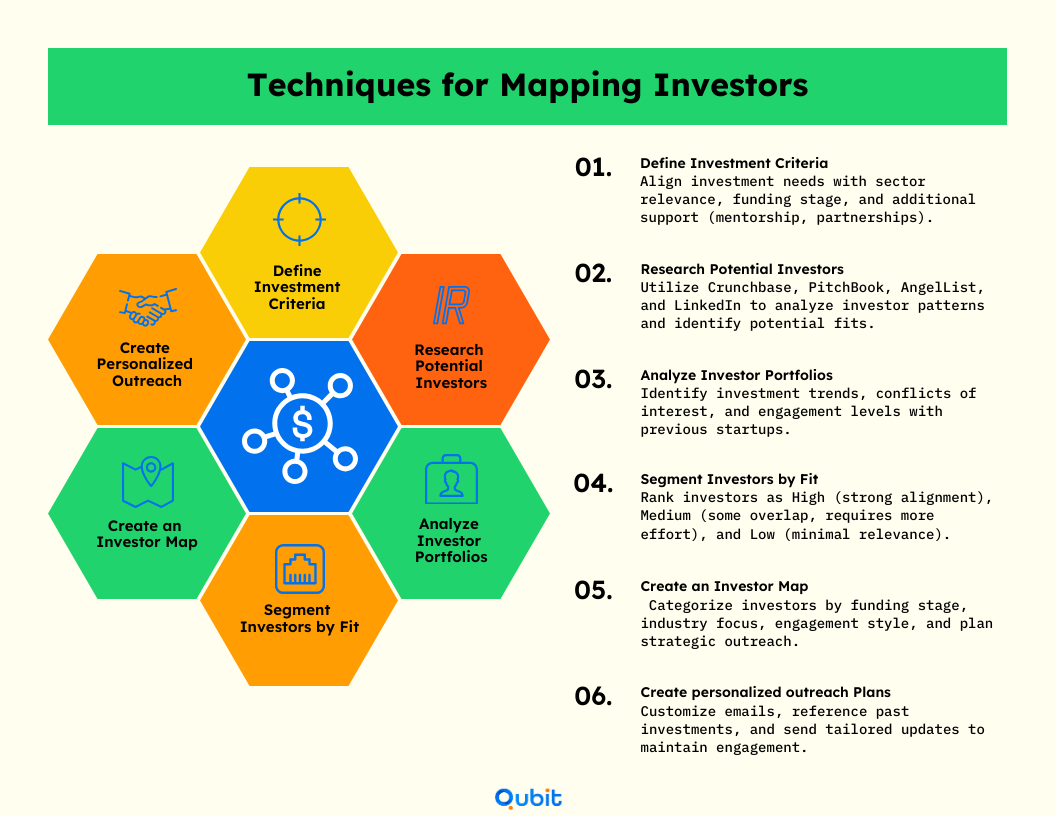
Define Your Investment Criteria
Before reaching out to potential investors, define what you’re seeking. This step ensures you target investors who are the best fit for your startup.
Align with Mission and Values
Your ideal investor should share or appreciate your startup’s mission and values. This compatibility leads to a more harmonious partnership and can significantly impact your venture’s success.
Actionable Steps:
- Identify Your Startup’s Core Values and Mission:
- Mission Statement: Clearly articulate your startup’s purpose and goals.
- Core Values: Define the principles guiding your company’s culture and decisions.
- Example: If your startup focuses on renewable energy solutions, your mission might be “To create sustainable energy alternatives reducing carbon footprints globally.”
- Determine the Ideal Investor Profile:
- Industry Focus: Investors specializing in your sector.
- Investment Size: The typical amount they invest per round.
- Geographic Location: Proximity can be advantageous, but global investors may also offer valuable opportunities.
- Stage Preference: Seed, Series A, Series B, etc.
- Additional Support: Mentorship, industry connections, marketing assistance.
- Example: An ideal investor might be a venture capital firm that invests $1–5 million in early-stage renewable energy startups and offers strategic partnerships within the energy sector.
Research Potential Investors
With your criteria in place, identify potential investors who match your ideal profile.
Utilize Tools and Databases
- Crunchbase: Offers detailed profiles on investors and their investment activities.
- AngelList: Connects startups with angel investors and job seekers.
- PitchBook: Provides comprehensive data on global capital markets.
- LinkedIn: Useful for networking and learning about investors’ backgrounds.
Advanced Search Strategies:
- Use filters to narrow down investors based on industry, investment size, location, and funding stage.
- Monitor news outlets and industry publications for announcements of recent investments.
- Attend industry events and pitch competitions to meet investors in person.
For a detailed walkthrough of these platforms, check out our article on essential investor discovery tools.
Analyze Investor Portfolios
Understanding an investor’s portfolio helps gauge their interests and assess whether your startup matches their investment history.
Purpose:
- Identify Investment Patterns: Do they consistently invest in certain industries or technologies?
- Assess Potential Conflicts: Ensure they haven’t invested in direct competitors.
- Evaluate Success Rates: Successful exits indicate a savvy investor.
Practical Steps:
- Review Past Investments:
- Examine the types of startups they’ve funded.
- Note the stages at which they invested.
- Look for Common Themes:
- Are they focused on innovation, disruption, social impact?
- Assess Engagement Level:
- Do they take active roles in their portfolio companies?
Dive deeper into this process with our guide on analyzing investor portfolios effectively.
Segment Investors Based on Fit
With your research complete, segment your list of potential investors to prioritize outreach.
Criteria for Segmentation:
- High Priority: Strong match with mission, values, and investment criteria.
- Medium Priority: Partial match; may require more effort to convince.
- Low Priority: Minimal match; consider deprioritizing to focus on higher-potential investors.
Tips:
- Use a scoring system to rate investors based on how well they match your criteria.
- Consider using a CRM tool to organize and track your investor outreach efforts.
Understand more about effective investor segmentation techniques.
Create an Investor Map
An investor map is a visual representation of your segmented investors, helping you plan your outreach.
Overview:
- Visual Tools: Use spreadsheets, mind maps, or specialized software.
- Categorization: Group investors by segment, industry focus, or stage preferences.
- Outreach Plan: Assign timelines and team members responsible for each investor.
Benefits:
- Organization: Keeps your fundraising efforts structured.
- Effectiveness: Helps prioritize high-potential investors.
- Clarity: Provides a clear roadmap for your team.
For a step-by-step guide, refer to our comprehensive tutorial on building an investor map.
Develop Personalized Outreach Strategies
Tailor Your Communication
Personalization is key to capturing an investor’s attention and demonstrating your diligence.
Strategies:
- Customized Emails: Reference specific investments or public statements made by the investor.
- Personalized Pitch Decks: Highlight how your startup aligns with their interests.
- Thoughtful Follow-ups: Send updates or articles relevant to their investment focus.
Advanced Insights:
- Utilize psychological principles like reciprocity and social proof.
- Understand their decision-making drivers, whether motivated by financial returns, social impact, or innovation.
Example:
Instead of sending a generic email, write:
“Dear [Investor Name], I was impressed by your investment in [Startup Name], particularly your support for AI-driven healthcare solutions. At [Your Startup], we’re utilizing AI to revolutionize patient diagnostics, and I believe our mission aligns closely with your investment interests.”
How Do You Map Investors for a Startup?
Step-by-Step Process:
- Define Investment Criteria: Establish your ideal investor profile based on mission match, industry focus, investment size, and more.
- Research Potential Investors: Use tools and databases to compile a list of potential investors.
- Analyze Portfolios: Assess each investor’s past investments for alignment and potential conflicts.
- Segment Investors: Prioritize investors based on how well they meet your criteria.
- Create Your Investor Map: Visualize your segmented list to manage outreach effectively.
- Develop Personalized Outreach Strategies: Tailor communication to resonate with each investor.
By following these steps, you’re not just reaching out to investors; you’re building a thoughtful fundraising approach that increases your chances of success.
Advanced Strategies
Personalization Techniques in Investor Outreach
Going beyond basic personalization can significantly improve engagement with potential investors.
Reference Past Investments in Communications
Demonstrating awareness of an investor’s portfolio shows you’re diligent and genuinely interested in partnering with them.
Example:
“I noticed your investment in [Company X], focusing on sustainable packaging solutions. Our startup complements this by providing biodegradable materials that could enhance offerings for companies like [Company X].”
Match Your Pitch with Investors’ Values and Interests
Understanding what drives an investor allows you to tailor your pitch accordingly.
Example: If an investor prioritizes social impact, emphasize how your startup contributes to societal well-being.
Sample Success Story:
Startup ABC secured funding from an investor known for supporting diversity initiatives. By highlighting their commitment to building a diverse team and promoting inclusive practices, they reflected the investor’s core values, leading to a successful partnership.
Understand Investor Psychology
Motivations Behind Investment Decisions:
- Financial Returns: Desire for profitable exits.
- Complementary Fit: Opportunities complementing their current investments.
- Innovation Potential: Interest in cutting-edge technologies or emerging business models.
- Social Impact: Ventures addressing societal challenges.
Application:
- Research Individual Investors: Understand their backgrounds and publicly expressed interests.
- Tailor Your Value Proposition: Emphasize aspects of your startup matching their motivations.
- Build Trust: Be transparent about risks and how you plan to mitigate them.
Explore our in-depth analysis of investor psychology for more insights.
Consider Cultural Nuances in Investor Relations
In a globalized economy, cultural awareness can be a significant asset.
Global Perspective:
- Communication Styles: High-context cultures (e.g., Japan) may rely on non-verbal cues, while low-context cultures (e.g., Germany) value direct communication.
- Business Etiquette: Formality levels, gift-giving customs, and meeting protocols vary widely.
- Decision-Making Processes: Some cultures prioritize consensus, others value swift individual decisions.
Strategies:
- Cultural Research: Understand the norms and expectations of the investor’s culture.
- Adapt Communication: Adjust your language, tone, and presentation style.
- Local Partnerships: Collaborate with local advisors who can bridge cultural gaps.
Example: When approaching investors in China, recognizing the importance of guanxi (relationships) and showing respect for hierarchical structures enhances rapport.
For more on navigating international investor relations, read our article on cultural considerations in global fundraising.
Sample Case Study:
Background:
TechInnovate, a startup developing AI solutions for healthcare, faced challenges securing funding due to the niche nature of their product. Generic pitches weren’t yielding results.
Process:
- Defined Investment Criteria:
- Targeted investors interested in AI and healthcare.
- Preferred those with a history of supporting early-stage startups.
- Conducted In-Depth Research:
- Identified investors who recently funded similar technologies.
- Used LinkedIn to find mutual connections for warm introductions.
- Analyzed Investor Portfolios:
- Noted investors with successful exits in healthcare tech.
- Avoided those invested in potential competitors.
- Segmented Investors:
- Created categories based on match and interest level.
- Prioritized those keen on AI advancements.
- Created an Investor Map:
- Used a mind-mapping tool to visualize potential investors and networking paths.
- Assigned team members to manage relationships with each segment.
- Developed Personalized Outreach Strategies:
- Customized pitch decks highlighting how their solution complements investors’ portfolios.
- Scheduled meetings to coincide with industry conferences the investors attended.
Results:
TechInnovate secured a seed round from Visionary Ventures, an investor focused on AI in healthcare. The investor’s industry connections and expertise accelerated the startup’s growth, leading to significant market traction.
Key Takeaways:
- Personalization Is Powerful: Customized pitches yielded higher engagement.
- Thoughtful Networking Matters: Leveraging mutual connections facilitated introductions.
- Right Investor Accelerates Growth: The perfect match brought more than capital.
Templates and Visual Aids
Utilize Investment Mapping Template
Simplify your investment mapping process with an Investment Mapping Template.
Description:
A comprehensive, user-friendly spreadsheet must allow you to:
- Input Investor Details: Contact information, investment preferences, portfolio highlights.
- Rate Match: Score how well each investor matches your criteria.
- Track Engagement: Monitor communication history and next steps.
Features:
- Pre-built formulas for scoring and prioritization.
- Sections for notes and meeting schedules.
- Customizable fields to suit your startup’s needs.
Access:
Discover more such templates designed to enhance your fundraising effectiveness here.
Infographics Illustrating the Mapping Process
Visual Aid 1: The Investment Mapping Steps
An engaging infographic outlining:
- Define Investment Criteria
- Research Potential Investors
- Analyze Portfolios
- Segment Investors
- Create Your Investor Map
- Develop Personalized Outreach Strategies
Benefits:
- Simplifies complex processes.
- Easy reference during team meetings.
- Enhances understanding for visual learners.
Visual Aid 2: Sample Segmented Investor List
This infographic displays:
- High-Priority Investors: Closely match your criteria.
- Medium-Priority Investors: Potential opportunities with some match.
- Low-Priority Investors: Less match but worth monitoring.
Benefits:
- Visual hierarchy aids in focusing efforts.
- Encourages team collaboration on prioritization.
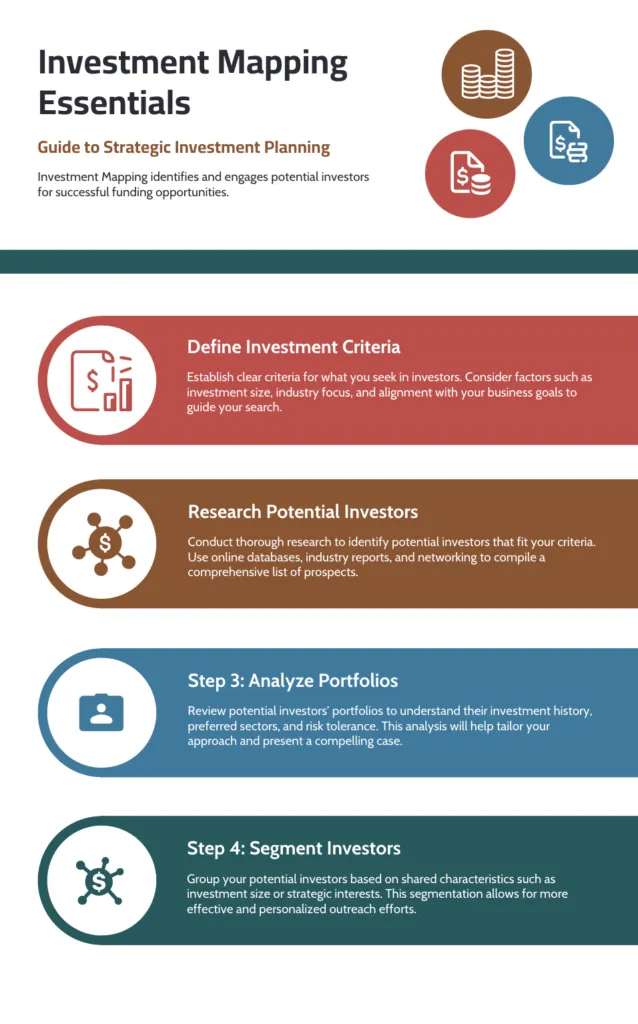
Conclusion
Finding the perfect investor match is pivotal to your venture’s success. Investment mapping equips you with strategies and tools to manage the fundraising process effectively.
By meticulously defining your investment criteria, you position your startup for fruitful partnerships that extend beyond mere financial support. Also invest time researching and analyzing potential investors to craft personalized outreach strategies,
Remember, the right investor brings not only capital but also valuable expertise, connections, and shared enthusiasm for your mission. As you implement these investment mapping techniques, you’ll find the fundraising process becomes more targeted, efficient, and successful.
Take Action Now:
- Start Your Investment Map Today: Utilize the templates and tools provided to begin mapping your ideal investors.
- Leverage Qubit Capital’s Expertise: Our team is dedicated to supporting startups like yours. Explore our services and solutions to see how we can assist your fundraising journey.
- Deepen Your Knowledge: For additional information, read our comprehensive guide on mapping the investor landscape.
Begin this strategic approach, and shape your startup’s future with confidence.
Key Takeaways
- Investment Mapping is Essential: A strategic approach focusing your fundraising efforts on the most suitable investors.
- Define Clear Investment Criteria: Know what you need and who can best provide it.
- Personalization Increases Success: Tailored communication resonates more with investors.
- Advanced Strategies Offer an Edge: Insights into investor psychology and cultural nuances can set you apart.
- Leverage Tools and Resources: Utilize templates, infographics, and databases to streamline the process.






